Oris and Sinn have released smaller versions of their popular dive watches, the Aquis Date and U50. What can these 41- and 41.5-mm-diameter newcomers do? Find out in this comparative review from our October 2020 issue, with original photos by Nik Schölzel.
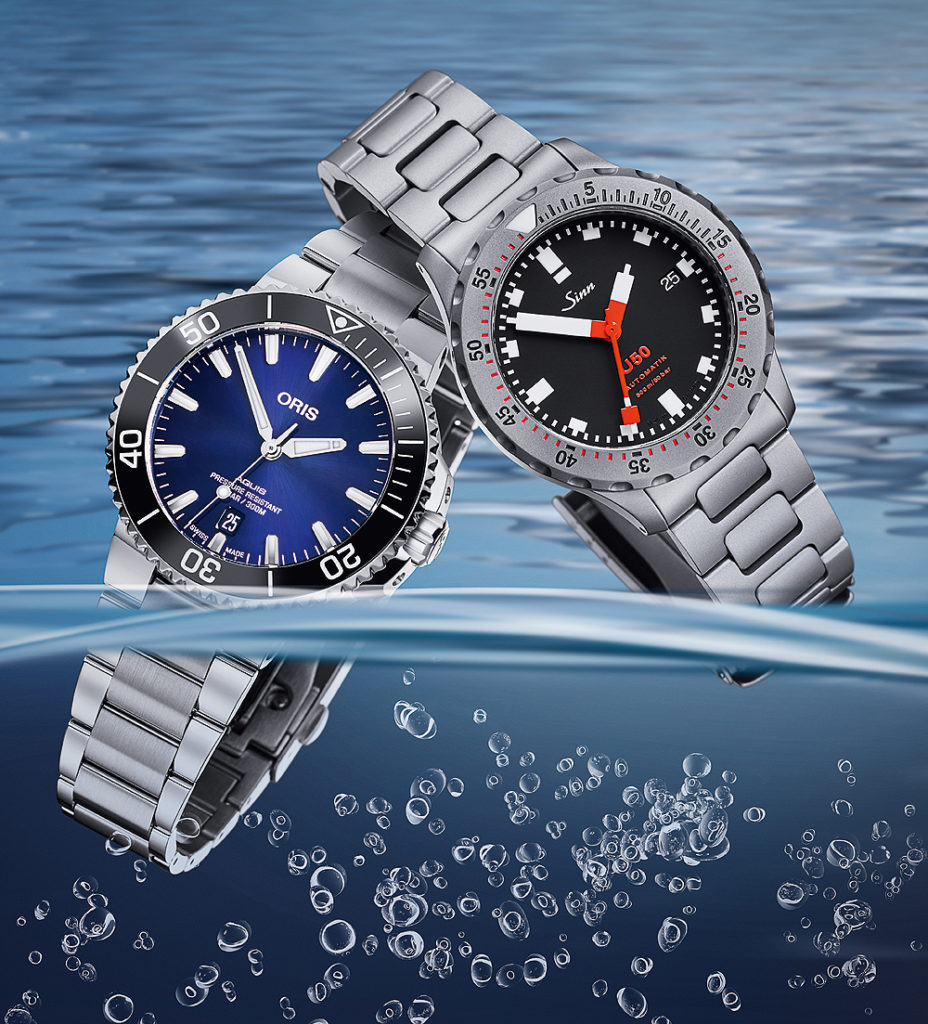
“Honey, I shrunk the U1” is the headline of Sinn’s ad for its new U50. And Oris is making a scaled-down version of its Aquis Date. Fortunately, however, these watches haven’t become quite as tiny as the children in the 1989 movie, Honey, I Shrunk the Kids. And their larger role models (the 44-mm Sinn U1 and the 43.5-mm Aquis Date) remain in the brands’ portfolios.
The victory march of gigantic watches is over; today’s trend is toward moderately sized timepieces. Sinn and Oris emphasize this with the 41-mm U50 and the 41.5-mm Aquis Date, our test watches. They have responded to their customers’ requests for a more moderately sized divers’ watch. The smaller dimensions of the models presented in 2020 have tangible advantages. These watches are more comfortable to wear, they aren’t so top-heavy, and they’re less likely to get caught on nearby objects, especially the U50, which is only 11.15 mm high.
These two moderately sized dive watches are visually very different from each other. Sinn bead-blasts the case and strap, relocates the crown away from the back of the hand to the 4 o’clock position, trims the dial with instrumental styling and optimizes legibility thanks to strong contrast between applied luminous material and a matte black background. Nothing reflects glaringly here and each element serves a practical function. The U50 thus instantly distinguishes itself as a professional tool watch.
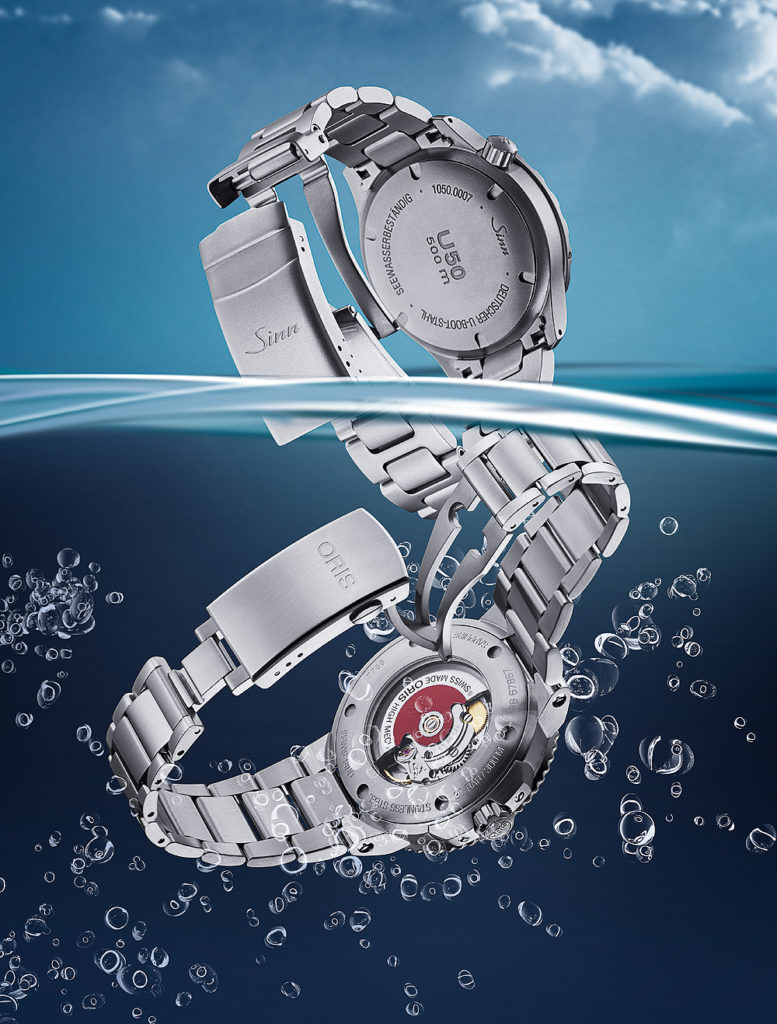
Brilliant Appearance
Oris, on the other hand, alternates polished and satin-finished surfaces, decorates the blue dial with a sunburst finish, and lets the polished ceramic scale on the rotating bezel sparkle in the sunshine along with the polished hands and hour indexes. While Sinn does everything it can to make its watch into an ideal companion for divers, Oris also strives to shine on dry land. After all, even a dive watch spends most of its time on terra firma.
Dive Deeper
These two very different concepts are also reflected in the watches’ functionality. With water resistance to a depth of 500 meters, the Sinn offers considerably more reserves than the Oris, which is pressure resistant to 300 meters, although even this lesser value is more than sufficient. Sinn has also arranged to have the DNV GL, the world’s leading classification authority and a recognized advisor for the maritime industry, certify the U50 according to the European standard for diving equipment. The U50’s crystal has anti-reflective coating on both sides and is extremely transparent. The chic curved crystal of the Aquis has anti-reflective coating on its underside, but reflections on the front allow you to take an inconspicuous look behind you as you read the time.
You can also see the watches’ differing character in their cases. As it did with some previous models, Sinn again opts to use submarine steel here. This is the same alloy that’s used for the hulls of Germany’s most up-to-date submarines. The material is extremely resistant to saltwater, so it’s particularly well suited for the cases of dive watches. Furthermore, it can be hardened very effectively via Sinn’s “tegementing” process. As with its U1, the Frankfurt-based brand hardens only the rotating bezel of the U50. This allows the watch to be sold at a lower price, but it also makes it tough enough to ward off nearly all scratches because the bezel protrudes above the case and works like a protective shield for the middle part of the case.
We tried it. We tried to scratch the bezel with a screwdriver made of hardened steel and used plenty of pressure, but no traces of the mistreatment could be seen, even using a magnifying glass. Sinn employs another proprietary technology for the bezel: three small screws ensure that this rotatable ring won’t fly off the middle section and get lost if the watch suffers a sharp blow.

Oris opts for a scratch-resistant ceramic divers’ scale atop a case made of conventional 316L steel, which can be polished easily. The crown protector looks very cool too: it’s held in place by Y-type screws instead of being milled along with the case.
Buttons or Bow?
The differences continue in the bracelets and clasps. Both watches offer divers’ fold-out extension mechanisms. But while the 1.3-centimeter extension of the Oris is sufficient to just fit around the sleeve of a 3-mm-thick diving suit, the Sinn’s 3.4-centimeter extension can accommodate the sleeve of a typical 5-mm-thick wetsuit.
Both makers rely on safety folding clasps. Here we like the Oris system, which is secured by a pair of push buttons and easy to use, better than the old-school solution from Sinn, where you first have to open the safety bar with your fingernail. But once you’ve strapped them around your wrist, both watches are equally comfortable to wear.
And what about their inner lives? The glass back of the Oris offers a clear view of Oris Caliber 733, which is based on a Sellita SW200 and embellished with Oris’s typical red rotor. In terms of quality, the unadorned movement is identical in construction to the ETA 2824, but Oris supplements the simplest version with higher-quality elements such as an Incabloc shock protection system.
Sinn uses the slimmer Sellita SW300, and although it’s concealed behind the case’s opaque metal back, it nonetheless boasts eye-appealing embellishments such as rhodium-plated components, clouds polished on the bridges, and blued screws. The ETA 2892 was the godfather here. Both large-series movements are considered to be reliable, but Sinn uses the much better quality level, with the Glucydur balance, while the Oris watch makes do with a simpler nickel balance.
The difference is also reflected in the rate performance. On the timing machine, the values of the U50 are only 5 seconds apart among the individual measurement positions. The average daily deviation is less than +5 seconds. With the Aquis, the average daily gain is also good at 6.2 seconds, but the measurements in the individual positions differ by as much as 13 seconds, which means that the deviation is not quite as uniform as with the Sinn.

In terms of price, the Oris is the slightly less costly option at $2,200, while the Sinn costs $2,260. Both timepieces offer good value, but you get a little more for your money with the U50 due to its innovative technologies and a better movement.
Sinn has designed its U50 as an uncompromising, pressure-resistant, professional dive watch with a rotating bezel that is scratch-resistant and virtually impossible to lose. The instrument styling also appeals to lovers of tool watches. You can also dive safely with the Aquis, but Oris uses intricate design details to ensure that its watch looks very handsome on dry land too. The bottom line? You don’t have to make any concessions because of their smaller size; both of these little watches are really big.
SPECS: Oris Aquis Date
Manufacturer: Oris SA, Ribigasse 1, 4434 Hölstein, Switzerland
Reference number: 01 733 7766 4135-07 8 22 05PEB
Functions: Hours, minutes, seconds, date
Movement: Sellita SW200 “Standard”/ “Spécial,” automatic, 28,800 vph, 26 jewels, stop-seconds function, rapid-reset function for the date display, Incabloc shock protection, fine adjustment via an index, nickel balance, 38-hour power reserve; diameter = 25.6 mm; height = 4.6 mm
Case: Stainless-steel case, ceramic bezel with calibrated scale, cambered sapphire crystal anti-reflectively treated on its underside, screwed crown, mineral-glass back, water resistant to 300 meters
Bracelet and clasp: Stainless-steel bracelet with secured folding clasp and fold-out extension mechanism
Rate results (deviation in seconds per 24 hours):
Dial up +12
Dial down +10
Crown up +5
Crown down +3
Crown left +8
Crown right -1
Greatest deviation 13
Average deviation +6.2
Average amplitude:
Flat positions 297°
Hanging positions 278°
Dimensions: Diameter = 41.5 mm; height = 13 mm; weight = 146 grams
Price: $2,200
SPECS: Sinn Model U50
Manufacturer: Sinn Spezialuhren GmbH, Wilhelm-Fay-Strasse 21, 65936 Frankfurt am Main, Germany
Reference number: 1050.010
Functions: Hours, minutes, seconds, date
Movement: Sellita SW300 “Premium,” automatic, 28,800 vph, 25 jewels, stop-seconds function, rapid-reset function for the date display, Incabloc shock protection, fine adjustment via an index, Glucydur balance, 42-hour power reserve, diameter = 25.6 mm; height = 3.6 mm
Case: Submarine steel, hardened rotating bezel, flat sapphire crystal has been anti-reflectively treated on both sides, screwed crown, fully threaded back made of submarine steel, water resistant to 500 meters and also secured against low pressure
Bracelet and clasp: Stainless steel bracelet with secured folding clasp and fold-out extension mechanism
Rate results (deviation in seconds per 24 hours):
Dial up +6
Dial down +7
Crown up +6
Crown down +4
Crown left +2
Crown right +4
Greatest deviation 5
Average deviation +4.8
Average amplitude:
Flat positions 300°
Hanging positions 274°
Dimensions: Diameter = 41 mm; height = 11.15 mm; weight = 148 grams
Price: $2,260
SCORES: Oris Aquis Date
Bracelet and clasp (max. 10 points): Handsome steel bracelet with practical safety folding clasp, but the divers’ extension is just long enough for a wetsuit sleeve. 8
Operation (5): The screwed crown is easy to use, as is the rotatable bezel and the clasp with its two push buttons. 5
Case (10): Richly detailed case with screwed-on crown protector, alternately polished and satin-finished surfaces, scratch-resistant ceramic scale on the bezel and more-than-adequate pressure-resistance 8
Design (15): A successful mix of functional and sporty yet elegant elements 13
Legibility (5): The time can be read quickly by day and by night. 4
Wearing comfort (10): The bracelet fits comfortably around the wrist. 9
Movement (20): A robust caliber in its simple version without embellishments 10
Rate results (10): The average daily gain is small, but the difference among the several positions is too large. 7
Overall value (15): Good price-performance ratio 13
Total: 77 POINTS
SCORES: Sinn Model U50
Bracelet and clasp (max. 10 points): Solid stainless-steel bracelet with a very secure folding clasp that’s stamped from sheet metal rather than milled; the divers’ extension mechanism is adequately long. 8
Operation (5): The crown and the rotatable bezel are easy to operate, but a fingernail is needed to open the clasp. 4
Case (10): Very cleanly crafted case made of saltwater-resistant submarine steel; scratch-resistant and impossible-to-lose rotatable bezel; plenty of extra depth in the water-resistance value; secured against low pressure; optimally anti- reflective crystal above dial 9
Design (15): This tool watch gets its aesthetic appeal from its uncompromising and functional instrument design. 12
Legibility (5): The time and the dive time are very easy to read in every situation thanks to strong contrast and plenty of luminous material. 5
Wearing comfort (10): A small and slim format assures that the U50 fits well around the wrist and isn’t top-heavy. 9
Movement (20): Sinn adds subtle decorative patterns to the top-quality version of Sellita’s time-honored caliber. 12
Rate results (10): The rate is regular in all positions, the average daily deviation remains quite small, and the amplitude is stable. 8
Overall value (15): The price is pleasingly low considering the many innovative technologies, which significantly improve this watch’s characteristics. 14
Total: 81 POINTS


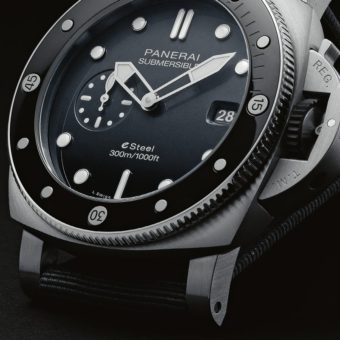
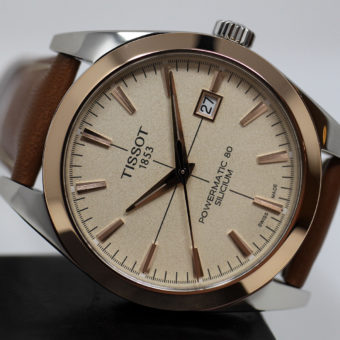
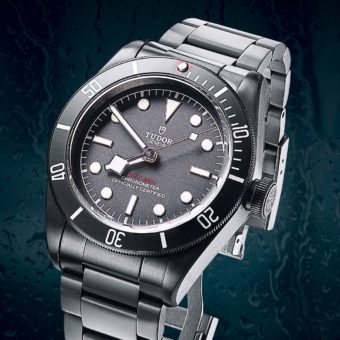

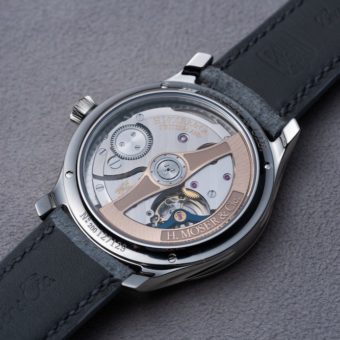
Excellent! I wish all comparison reviews were done like this. I appreciate the facts of each watch were clearly defined, not left to subjective preference. Thanks
Enjoyed the review and the comparison was excellently balanced between the selection of watches choosen.
Enjoyable article with unbiased content. Very good comparison between the various attributes of each watch. I think you kept the subjective attributes out, with no mention of personal inclinations to style, finishing, or functional preference, such as crown at 3 or 4, AR coatings or bezel implications. I hope to read more such articles from you. Thanks
There is something to be said for watch brands that use a higher grade mechanical movement calibre. The top grade is more robust and accurate than its lower grade counterpart, and the little to moderate price difference is well worth it. I’m a little suspicious of a watch company that won’t use a higher grade, given the small investment versus the greater gain in performance. And for the price it seems like a no brainer.